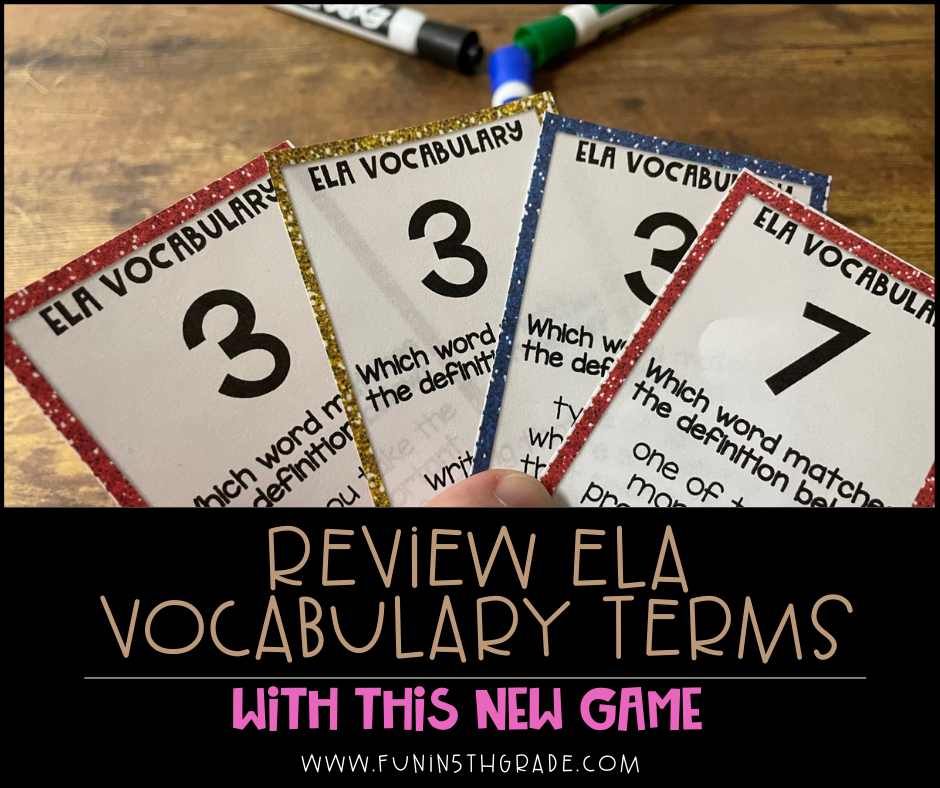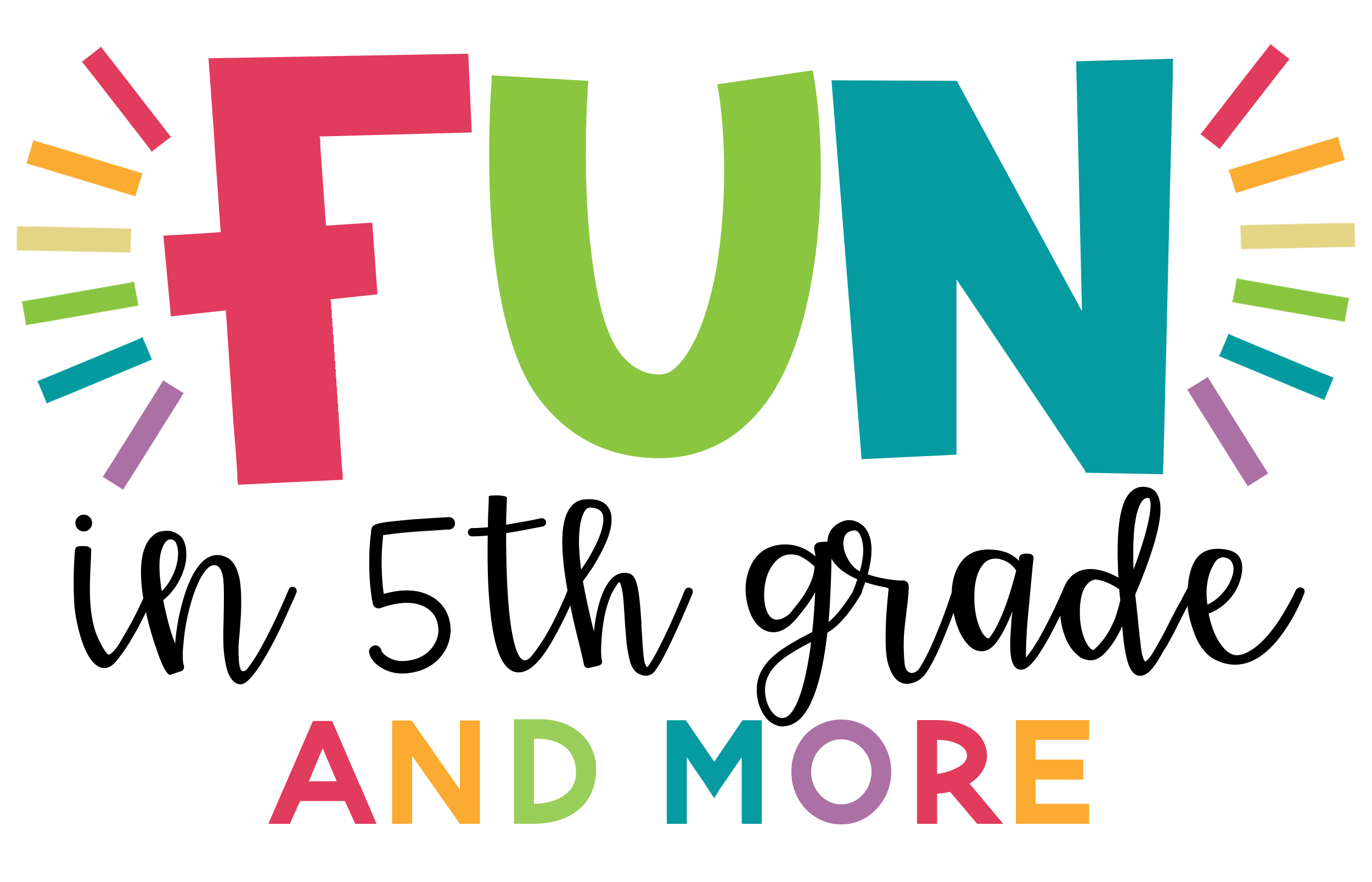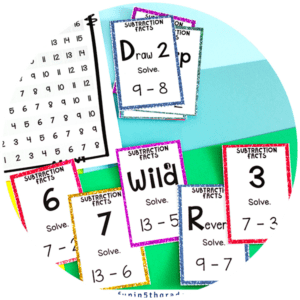If you are looking for a new way to review ELA vocabulary terms, this free U-KNOW deck and the fun card game we lay out in this post may be exactly what you need!
One thing I love about U-KNOW decks is that, if you take the Wilds out, the decks have almost the same number of cards as a standard deck of cards. In addition to the 9 number cards, there are three additional types of cards in each color a Skip, Draw 2, and Reverse, which means that each U-KNOW deck is really only 4 cards shy of a standard deck of cards.
Why does this matter?
Because it means that most typical card games can be played with a U-KNOW deck.
That is pretty exciting if you like a good game of cards as much as I do.
Today, we’re going to take an old card game and adapt it specifically to be used with a U-KNOW deck like our ELA Vocabulary Terms Freebie.

SPOONS…or should I say MARKERS
Now when I was originally taught this game, we called it Spoons, but since we are adapting the game for classroom use, we are calling it Markers.
To set up the game, you’ll need…
- 4 students in each group.
- one laminated deck of the ELA Vocabulary Terms U-KNOW cards with the Wilds Removed.
- 3 markers for each group.
To begin, the cards will be shuffled, and each student will receive 4 cards.
The student who shuffled will keep the remaining cards directly in front of them.
The markers will be arranged in a circle in the middle of the group. It is important that the markers are within reaching distance for all the students in the group.
To start the game, each student will look at their cards and take a moment to arrange them in whatever way they would like.
Then the person who dealt (we’ll call this student Player 1) will pick up the first card off the top of the remaining deck of cards and either choose to replace a card in their hand or pass on the card to the next person. If they choose to keep it, they’ll take the card they are replacing out of their hand and lay it face down to the right of the player to their left. They will then pick up the next card from the top of their deck and repeat the process. If they choose not to use the card, they’ll simply lay it face down next to the person on their left. As soon as they lay down the card, they will pick up the next one off the deck and repeat the process.
The person to the dealer’s left (we’ll call this student Player 2) will pick up the card that was given to them by Player 1 and decide if they want to discard it or replace one of the cards in their hand. If Player 2 chooses to discard it, they will simply place it face-down to their left for the next student to pick up. If they choose to replace a card, they will switch out the cards and still discard to their left, where the third person can now reach the card. By the time they have decided, Player 1 will have most likely already passed them another card to look at.

This process will be repeated until one of the students is able to meet the goal of the game. The goal is to collect four cards of the same number or type to create a 4-of-a-kind.
Once they get a 4-of-a-kind, the student will grab one of the markers from the middle of the group. As soon as the other students see that someone has taken a marker, they will grab one of the other markers. Like musical chairs, one student will always be left without a marker.
Since we are using U-KNOW cards instead of regular playing cards and this game is being used for review, we have one more step to our game.
To truly win the game, the student who got the 4-of-a-kind must read the questions on each of the cards aloud and say the answers. If they get all the answers right, they win 4 points. If they don’t, then the person who grabbed the marker second will pick a number out of their hand, read any and all of the questions with that number in their hand, and provide the answers. If they are right, they get a point for as many of that card as they had in their hand.
Example #1: If Monica was the second person to grab a marker, and she had 2 of the Reverse cards in her hand, along with a ‘6’ card and an ‘8’ card, she could choose to answer either the Reverse questions, the 6 question, or the 8 question. If she chooses to answer the Reverse questions, then she’ll have to answer both of them correctly to get two points. If she chooses to answer the question on the ‘8’ card, then she only has to answer one question, but if she gets it right, she only gets one point. If she gets the answer wrong, then the person who picked up the third marker will get to choose a card or series of cards out of their hand to answer.
Example #2: If Monica has a 2, 6, 9, and Skip in her hand, and she chooses to answer the question that goes along with the 9, then as long as she is correct, she only gets 1 point.
IMPORTANT: Only one student will earn points each round.
If the second person doesn’t get the answers right, the third person to pick up a marker will have a chance. As long as someone earns points, the person who did not grab a marker will go down one point. If none of the other three students are able to answer the questions correctly to earn points, then the person who didn’t grab a marker in time will not be penalized.
Once points are awarded and documented, the students will shuffle the cards again and repeat the game for 8 total rounds. This allows each person in the group to be Player 1 (or the dealer) twice. At the end of 8 rounds, the points will be added up, and the winner will be decided.
What I like about this game
This is a great review game because it is best played when the questions aren’t new to students. We want them to be familiar with the ELA vocabulary terms and definitions before they have to answer four questions in a row.
This game is also perfect for test prep because students are hearing the same questions and answers over and over. Technically, different people in the group could win by finding all of the 2s multiple times. This allows students to hear those same questions and answers many times throughout the game.
I also like that this game is fast-moving. Each round will go by quickly as the goal of the game is to get 4-of-a-kind as quickly as possible.
Lastly, you can easily add an addition 1-2 people to any group, and the game will still work, so teachers don’t have to worry about having an odd number of students or combining groups if students are missing.
Suggestions/Options:
- Don’t allow students to get the same 4-of-a-kind more than once. So if Player 1 gets a 4-of-a-kind in 8s, then he can’t go for 8s again. Someone else can get the 4-of-a-kind with the 8s, but not Player 1.
- Keep track of points with chips or tokens of some kind for easy scorekeeping
- Place 5 students in each group, but one person will sit out each round to act as the answer checker. This will allow the question/answer portion to move more quickly.
- Definitely take the time to laminate the U-KNOW cards and the answer sheets. These will be handled a lot as part of this game. Be sure to check out this post about making your games last for some of my personal suggestions for taking care of your class games.
- Once you’ve practiced this game with the Free ELA Vocabulary Terms U-KNOW cards, try it with some of these other U-KNOW decks.
Looking for more ways to use those U-KNOW cards, we’ve got a great post for you. In 4 Ways to Reuse and Repurpose U-KNOW cards, we’ll give you some additional activities you can use with these same cards in the future!





